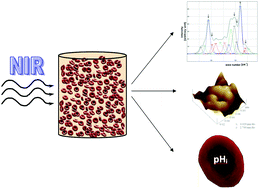Near infrared light induces post-translational modifications of human red blood cell proteins
Abstract
There is a growing body of evidence that near infrared (NIR) light exerts beneficial effects on cells. Its usefulness in the treatment of cancer, acute brain injuries, strokes and neurodegenerative disorders has been proposed. The mechanism of the NIR action is probably of photochemical nature, however it is not fully understood. Here, using a relatively simple biological model, human red blood cells (RBCs), and a polychromatic non-polarized light source, we investigate the impact of NIR radiation on the oxygen carrier, hemoglobin (Hb), and anion exchanger (AE1, Band 3). The exposure of intact RBCs to NIR light causes quaternary transitions in Hb, dehydration of proteins and decreases the amount of physiologically inactive methemoglobin, as detected by Raman spectroscopy. These effects are accompanied by a lowering of the intracellular pH (pHi) and changes in the cell membrane topography, as documented by atomic force microscopy (AFM). All those changes are in line with our previous studies where alterations of the membrane fluidity and membrane potential were attributed to NIR action on RBCs. The rate of the above listed changes depends strictly on the dose of NIR light that the cells receive, nonetheless it should not be considered as a thermal effect.


 Please wait while we load your content...
Please wait while we load your content...